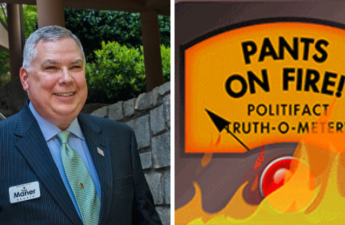 Note: Brambleman recently received the Benjamin Franklin Award for popular fiction, and to celebrate this honor, Thornbriar Press has put the Kindle version on sale through June for only $6.99 — $2 off the regular price.
Note: Brambleman recently received the Benjamin Franklin Award for popular fiction, and to celebrate this honor, Thornbriar Press has put the Kindle version on sale through June for only $6.99 — $2 off the regular price.
* * *
Forsyth County, Georgia is the site of one of the most infamous acts of ethnic cleansing in American history. In late 1912, white mobs and nightriders drove out more than 1,000 black residents from the community. Their success was remarkable in its completeness, and Forsyth, in the shadow of the black Mecca of Atlanta, remained lily-white for nearly a century afterward.
I first came up with a primordial idea for Brambleman in 1993 and started writing something resembling this book in 1998. Ten years later, I finished the manuscript. Even though fictional, my work involved a large amount of background research, which is fitting. After all, the novel is an outgrowth of my work on my late father’s nonfiction book, The Way It Was in the South: The Black Experience in Georgia.
In fact, Brambleman’s Prologue begins on January 24, 1987, the day of Hosea Williams’s second Brotherhood and Anti-Intimidation March in Forsyth County. (Williams and his followers had been run out of town by Klansmen and neo-Nazis the week before. Heck of a story.) The plot doesn’t hover there, however. Instead, it picks up in present-day Atlanta to tell the story of Charlie Sherman, who is charged to finish a dead professor’s book about events in 1912 Forsyth County. Many reviewers have called it a “wild ride.” I don’t argue.
Names have been changed and details added, but my account is informed by the news coverage and chronology of that time. Snark is my own.
From Brambleman, copyright 2012 by Jonathan Grant
Chapter Five
When Charlie Sherman finished reading Thurwood Talton’s 1,087-page manuscript, he knew more than anyone else alive about what had happened in Forsyth County nearly a century ago. The nugget of Dr. Talton’s magnum opus was buried deep inside myriad observations and countless facts, starting with the weathering of the Blue Ridge Mountains, winding along the Trail of Tears, and ending at a hateful, crudely lettered sign at the county line.
The incident that originally sparked Forsyth’s madness was an event of questionable authenticity: an alleged “outrage” against a white woman near Deep Creek, five miles north of Cumming, the county seat. On the night of Thursday, September 5, 1912, the unnamed victim (first identified as a farmer’s wife, then as a young woman living with her mother) awoke to find a black man in her bed, so the story went. “Imagine her surprise!” Talton wrote. “Like Casablanca’s gendarme, she was shocked, SHOCKED, at this occurrence!” More likely, the professor suggested, she was caught in bed with a black man and cried Rape! to save her honor, which, to white folks, was infinitely more precious than a black man’s life, especially in Georgia, the state responsible for half the nation’s lynchings that year.
The man and his rumored accomplice (whose existence was debatable) were frightened by the woman’s screams and ran off. Almost immediately, posses formed and combed the area for suspects. While Talton’s account was prosaic, Charlie’s espresso-fueled reading allowed him to see vigilantes whipping galloping horses through the night, accompanied by silent-movie chase music.
Meanwhile, a man variously identified as the victim’s father or husband rode into the sleepy town of Cumming, population 813, and tried to stir up a mob, failing only because there was no suspect. Lynching prospects improved the next day after two black men were arrested. One, a field hand named Ronnie Harris, immediately confessed, according to the nearby Gainesville newspaper. Such “confessions” often came after torture, beatings, and threats of lynching coupled with a lack of legal representation for the accused. Then again, the newspaper could have fabricated the claim. Nothing increased circulation like the terror threat/morality play of black-on-white rape, not to mention the resultant mob activity. “In 1912 Georgia,” Talton noted, “black suspects were lucky if they were considered innocent until proven arrested.”
While Harris was presumed guilty, he had supporters among Forsyth’s 1,159 blacks—ten percent of the county’s population. At noon on Saturday, September 7, a stocky, bald black Baptist preacher named Lincoln Roberts stood in the dusty street outside the courthouse where Harris was jailed. Roberts, born shortly after the Civil War, had lived in Forsyth County all his life and claimed to know the parties involved, none of whom were Ronnie Harris. Declaring that the prisoner had been unjustly accused, Roberts called for Harris’s release. A crowd of black workers, sharecroppers, and farmers gathered around him. There was no rape or attempted rape, Roberts stated, but simply consensual sex. “The woman’s affection for her black paramour was so great she refused to name the man who slipped from her bed and out the window!” Roberts shouted.
The white press would later denounce and condense his speech, stating, “The insolent Negro made remarks about the woman’s character.” Claiming that a white woman would willingly have anything to do with a black man carried the death penalty by mob back then, of course, so Roberts’s “insolence” was cut short when a dozen whites broke through the crowd and roughly seized him. Several drew pistols and pointed them at his head. He was forced to kneel. A man uncoiled a horsewhip and laid into the preacher, lashing through his coat and cutting strips of flesh. Roberts tried to run, but he was clubbed with a pistol butt and knocked down in the dirt. The whipping continued, along with beating and kicking.
Eventually, Sheriff J.A. Wright and deputies emerged from the courthouse to arrest the half-dead Roberts. As they dragged off the preacher, a growing white mob called for his lynching. Wright would later explain that he’d arrested Roberts to save him. It’s worth noting that none of Roberts’s assailants were charged in the assault. “A white man’s right to beat a nigger is the cornerstone of Georgia law,” State Sen. Preston Standers proclaimed in 1910, and nothing had changed in the two years since.
The preacher’s arrest did not calm things down. In the collective white mind, a black conspiracy to commit outrages against white women grew and festered. Four other blacks were arrested on the rather vague charge of “suspicion,” also a lynching offense, though one that was used mainly to fill county chain gangs for road work. (The state’s infamous convict-lease system had been abolished in 1908.) Word of Roberts’s beating spread, angering local blacks who believed he had been attacked for telling an unpleasant truth. Apparently, everyone knew this woman.
By this time, Atlanta papers were covering the story, adding fuel to the fire—as they did in 1906, when false reports of black-on-white crime helped spark the Atlanta Riot. Whites responded by threatening mass lynchings. Rebecca Felton, a populist race-baiter, summed up white feelings succinctly when she said, “If it takes lynching to protect women’s dearest possession from drunken, ravening beasts, then I say lynch a thousand a week.”
While reports of black insurrection turned out to be false, feverish whites made good on their threat to form mobs. Word of Harris’s confession brought armed whites cascading from the hills. By Saturday afternoon, hundreds surrounded the courthouse. As a barrel-chested, red-headed farmer in work clothes waved a hangman’s noose in the air, the crowd called for Wright to deliver Roberts and Harris to “justice”—meaning them, of course. The sheriff refused; the mob tested his mettle. A hundred men rushed the building. Wright fired a single warning shot. The crowd fell back after this massive display of firepower but didn’t disperse. A chant arose: “Burn ’er down! Burn ’er down!” In a footnote, Talton wrote: “Courthouse arson is a proud Forsyth County tradition.”
Following a series of frantic phone calls between the mayor of Cumming, Sheriff Wright, and Gov. Joseph M. Brown in Atlanta, martial law was declared in Forsyth. Brown, the son of Georgia’s Civil War governor (and who would later participate in the 1915 lynching of Leo Frank), ordered militia units from Marietta and Gainesville to quell the riots that threatened to tear apart the rural county. Thirty heavily armed troops from Gainesville were quickly dispatched to Cumming, arriving late Saturday afternoon. That night, under tight security, the sheriff moved Roberts and Harris— “the cause of all this trouble,” according to the Atlanta Citizen—to the Marietta jail in Cobb County, thirty miles away.
Wright hoped his actions would defuse tensions, but outrage among poor whites kept growing, fueled by long-standing antagonisms toward blacks. Not surprisingly, there was a run on rifles and ammunition at Whitsitt’s General Store. Heavily armed whites milled about Cumming looking for insolent Negroes and breaking the windows of black-owned houses, since home ownership was the surest sign of uppityness. Sensing trouble settling over the town like an oppressive fog, black families packed their belongings into horse- and mule-drawn wagons. The most prescient of them were halfway to Gainesville or Atlanta by Sunday morning, when newspapers published stories reporting that Negroes were plotting to blow up Cumming with dynamite in retaliation for the attack on Roberts.
In Cumming, as cocks crowed and cattle lowed in pastures, armed whites who’d slept in wagon beds with rifles woke with empty whiskey bottles beside them and faced the ugly truth of a new day: There was no one to lynch and only church to attend. For the moment, all was quiet. But that wouldn’t last. “Violence begets violence,” Talton wrote, “and the mob’s darkest desires and prayers to an angry God would soon be answered.”
To be continued.
Liked this post? Follow this blog to get more.



